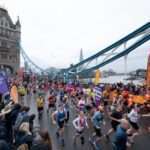
In many people’s opinion, London is the greatest city in the world. With a population of just under 9 million, it is also one of the most diverse, with an array of cultures that encompasses upwards of 300 languages, making it a truly global destination.
For tourists it is a magnet with so much to see and do. From the obvious attractions like: Buckingham Palace, the Tower of London, Tower Bridge, Big Ben, the Shard, and Trafalgar Square, to the more select sights such as: the London Eye, St Paul’s Cathedral, Wembley Stadium, Piccadilly Circus, and the Cutty Sark and Royal Observatory at Greenwich.
Additionally, there is also the West End theatres to catch a show; plus multiple museums such as the Natural History, Tate Modern, British, Science, and the Victoria and Albert, to explore. The place is incredible and visitors flock from every corner of the globe to enjoy its delights.
Like any city, it has had its problems with crime and disorder, but essentially, it has been regarded as a safe city, certainly when compared to some of the other megacities in other parts of the world. However, in recent years statistics have shown a sharp rise in both serious and micro criminality.
There have always been areas considered unwise to visit, especially after darkness descends, but that could be levelled at most cities and large towns. The recent concerns have centred more on the surge in crime taking place in daylight and also in parts of the capital that would usually be regarded as low risk.
Comparison’s have been drawn to New York City at its worst in the 1990’s, which is open to debate, but there has been a noticeable shift in the wrong direction, for which there could be several explanations, which are identified in more detail below.
Policing in London
It is the Metropolitan Police (often referred to as simply “The Met”) who are overseen by the Mayor of London’s Office for Policing and Crime (MOPAC), that have responsibility for the policing of Greater London, with the exception of the City of London, a small area in the heart of the capital, which has its own force.
The London police forces have established a good name for themselves across the world, but that is not a view necessarily shared by the citizens of the UK’s sprawling capital. They are, by and large, a very professional outfit, but they are called to deal with a wide variety of crimes and there has been criticism levelled at them for their prioritisation in certain areas; plus their presence on the streets has dwindled significantly.
Muggings and robberies
The opportunist thieves can be found in many tourist location and London is no different to any popular destinations, but due to its size there just are more of them. However, visitors tend to think this is just pickpockets on the busy streets, but they actually lie in wait in places many do not stop to consider.
Robbery is common if individuals fail to act with care and attention in places such as hotels, tube trains, buses and in shops. Hotels especially are establishments where people tend to let their guard down. Some people drop their bags down when approaching a reception desk and having been momentarily distracted, they turn to find that their luggage has been swiped.
Another growing trend is for identity and bank card theft. Crooks will snap a quick photo of somebody’s passport or bank card, maybe left for a few seconds on a table or check-in desk, and then use the details for fraudulent purposes. It almost slight of hand, but there are many who are adept at the practice, so vigilance is called for.
Out and about enjoying the sights, it is very easy to relax and presume all is good. Well-connected areas do tend to be safer, but being aware of the surroundings where ever that might be, is an approach everybody would be advised to adopt. Any valuables probably should be left in the hotel safe, but if it is necessary to carry them about, people really should aim to keep them out of sight. Wallets or phones poking out of back pockets are almost demanding to be lifted in the eyes of the criminals.
Towards the end of the day people should avoid badly lit areas and places where it is possible to become isolated for a time, as these are where muggings are most likely. Safety in numbers is the key, so keeping where the crowds are is best, but at the same time remaining conscious of who is around. It is common sense really, but it genuinely only takes a few seconds for a robbery or mugging to occur, and many times the victim realises after the event that they had been complacent in their situation. Looking confident and familiar with the surroundings goes a long way to deterring a would-be mugger.
Moped attacks
There has been quite a spike in moped crimes in London and these have a tendency to happen in the more affluent parts of the city, and worryingly, they are occurring in broad daylight. In recent times there were two quite frightening attacks in the Mayfair and Belgravia areas. Mayfair is a particularly wealthy environment with many diplomats residing in the West End district, on the edge of Hyde Park between Oxford Street and Park Lane.
It was here that a millionaire’s £3m Bugatti supercar was attacked by moped riding robbers who were dressed as Deliveroo riders. The victim had just left the smart Berkley Hotel and was clearly targetted, with witnesses claiming the thieves had followed the vehicle from Hyde Park Corner. One of the riders repeatedly hammered at the window with a claw-hammer, but was unsuccessful in gaining entry into the car.
They both wore balaclavas, helmets and gloves to disguise themselves. Their focus was expensive wristwatches and the driver had apparently flaunted his timepiece on his social media platform. On the same day in the same area, the pair stole Rolex watches from two brothers and later a respectable married couple were confronted by the moped riding duo armed with a knife and machete.
Another favourite practice of moped thieves is to speed along a pavement targetting lone commuters early in the morning, usually obliviously chatting away on their mobile phones. The mopeds themselves are usually stolen, often from innocent delivery riders.
Police response
Londoners have become increasingly frustrated at Mayor Sadiq Khan’s failure to tackle serious crime, and micro-crimes can be added to those grievances. After receiving a lot of criticism regarding their policy to “stop and search” the force took a step back, but this has had a negative effect elsewhere. The robbery rate has increased significantly and reflects the underlying prevalence of the crime. It goes hand in hand with the decline in both personnel and funding for the London Metropolitan Police.
Naturally those in top positions will point to these facts as valid reasons for a reduction in the police presence on the streets, but there is no escaping the fact that by being less visible, the prevention of immediate opportunities for violence has slipped, as has an offenders perceived risk of being apprehended. Criminal damage and anti-social behaviour has risen alarmingly, as these crimes are seemingly regarded as low priority to the Met and very often investigations are never even followed up.
High risk areas/dangerous boroughs
Violence and crime in London is spread all over the capital, but there are certain boroughs where it is definitely more concentrated. Also, there are several boroughs where although the figures may be low, or certainly decreasing, there remains specific locations within them where violence and crime is actually quite high and/or increasing. The most dangerous London boroughs according to some of the most recent statistics released suggest the following ten all have more than 100 crimes per 1,000 people:
Westminster – Despite its location and being home to a host of very important establishments, it is actually the worst for crime rates, probably tied in to the number of tourists in the vicinity on a daily basis.
Kensington and Chelsea – This is another affluent area but unfortunately money attracts the attention of the criminals, with a particular hotspot around the Earl’s Court area.
Newham – This has a poor reputation for personal attacks with theft a common occurrence. It also has a lot of drug-related crime too, so vigilance is a necessity. In a local survey only around a third of people declared they felt safe at night.
Islington – Irrespective of being the second smallest borough in London, Islington still has some serious crime problems. Theft and violence seems to be pretty evenly spread, plus rather sinisterly, high levels of sexual aggression, especially on public transport.
Lambeth – This popular destination has a major problem with possession of dangerous weapons which sadly goes hand in hand with violent crime. Most of the offences occur at night so visitors should bear that in mind.
Camden – This is a hugely popular area, attracting massive numbers of visitors and the pickpockets are out in force here, as are the moped and bicycle robbers. Complacency is understandable due to the bustling market in the day and lively nightlife, but a great day can quickly take a negative turn for the worse, through lack of precaution.
Hackney – There are many green spaces here, which sadly also attracts the wrong elements. This borough’s rate of crime is around 20% higher than the rate of crime for London as a whole.
Southwark – With the Shard sitting majestically as a centrepiece of this borough, it naturally attract many tourists, which in turn attracts the criminals. There are many reports of assaults and acts of aggression, with street theft prevalent.
Haringey – Burglaries are high up the list here and it is advised not to wander alone at night, particularly in badly lit places.
Hammersmith and Fulham – Possibly not one that would be expected to be in the worst top ten, but again wealth draws the criminals and theft here is very high. Its dense population doesn’t help the statistics, but anyone visiting should be guarded at all times.
Smart areas just as much at risk
There are quite a few smart areas that are finding that crime has come to its streets. Mayfair, Knightsbridge, and South Kensington are all attractive districts, but can also be relatively quiet at night. Mayfair, the fashionable, cosmopolitan neighbourhood pitched right in the heart of London, within the City of Westminster, would not be somewhere anyone would particularly associate with crime. Its reputation is more in line with high-end designer shopping, top-rated dining, and first-class entertainment options; as well as beautiful parks and manicured gardens. It is also where many of the city’s most luxurious hotels, including the Ritz and the Dorchester, are situated; plus home to a number of embassies and consulates.
However, it does tend to have very few people on its streets after a certain time, leaving individuals vulnerable to those who look for opportunities to commit attacks. Not only are they exposed to the initial assault, they are often left without anyone to come to their aid. That said, some of the criminals are so brazen they will think nothing of attempting a robbery in broad daylight. A video did the rounds recently showing a man stalking a person and approaching them just as they were about to enter a restaurant on Berkley Square. The stalker launches an attack and escapes with his victims watch, which continued a trend in the upmarket areas for theft of expensive luxury watches.
On the very same day another camera captured a brave elderly woman armed with a stick, confronting a masked knife-man, who had stolen a £60,000 Rolex from a woman in the street in Chelsea.
Court backlogs
Sir Peter Fahy, a former chief constable has blamed a backlog of court cases for the spate of crimes. He said the delays had meant some offenders were spending more time on bail and as a consequence, reoffending. He said: “The main issue if you are dealing with young criminals, is crucially you get them into court quickly, because if they are out on bail, the chances are that they are going to commit more crime, which puts more work back into the system and creates more victims.”
Tourist comments
A prospective traveller from San Diego spoke openly about how they had postponed plans to come to the UK with their children because of the reports of random attacks in its capital city. They said: “I believe it is rare but London especially has a relatively high rate of attacks including random acid attacks, which to all intents and purposes, ends any quality of life for the victim.” They went on to add: “I don’t feel the UK is doing enough in terms of restricting vitriolic materials nor mandatory sentencing; I would expect this issue to become a major one regarding travel to the UK and London in particular.”
Another traveller from Canada was especially critical of his trip to the city, stating: “I found London to have become a dangerous mess; we have travelled the world and never felt so scared and worried like we were about to be robbed or mugged, as we were when we were in London.”
Situational crime prevention and drugs and alcohol
Undoubtedly, there is a strong link between drugs and alcohol and violence and crime. For many it triggers aggression and releases inhibitions and can be a drive towards acts of criminal behaviour. It also can make victims more vulnerable, causing them to become less aware of surroundings and exposed to an attack.
Situational crime prevention can reduce opportunities for criminal actions, through changes to the immediate environment and perceived social pressures towards committing crime in the first place. Any sort of advanced awareness of potential criminal activity, where prevention can be instigated, has to be a move in the right direction; but very often these situational preventative measures require cooperation from multiple agencies, so can be difficult to regulate.
High profile victims
Sajid Javid himself should know how the victims of these crimes feel as he too was mugged a while ago. His mobile phone was snatched by moped thieves outside Euston railway station in the north of the city. He explained: “It happened in a flash, I reached for my phone to call a taxi and before I knew what was happening, it had gone. They just rode up, grabbed it and zoomed off.” He said he was angry and upset, but considered himself fortunate not to have been stabbed or beaten up.
Comedian Michael McIntyre was another watch theft victim, once again at the hands of moped thieves. He had gone to pick his children up from school in his Range Rover in Golders Green, north London, when he was subjected to a terrifying attack with thugs smashing the windows of his vehicle, before making off with his Rolex watch. He was left badly shaken and alarmed at how vulnerable everyone is, even when seemingly safe inside their own vehicle.
Public’s observations to daylight attacks
MP for Chelsea Greg Hands has spoken of his horror at the daylight attacks being carried out in supposedly quiet, respectable areas of London. He said: “There is obviously a real problem with moped attacks in broad daylight in Chelsea. Their motivation is to steal watches, but it is not a crime to wear an expensive watch.” He went on to talk about a constituent of his who was attacked with a machete for their watch and called for the police to do more.
A local woman of the immediate area made the point: “It’s not surprising that these sorts of crimes occur anywhere in London really.”
Another in the neighbourhood said: “There has been somebody around Battersea stealing phones from people’s hands while they are on a bike, but you don’t really think about it until it happens to you.”
e-bike getaways
A further development has seen criminals adapting tactics with £3,000 e-bikes and posing as commuters. The apparently are now opting to use the quieter e-bikes for their getaway vehicles and wear brogues over trainers, in an attempt to blend in with crowds. These bikes are being stolen and then adapted with modifications, which allow them to travel both on and off road, at speeds that can reach in excess of 35mph. They then ride around in small groups, snatching up to 40 phones every single day from the hands of unsuspecting pedestrians, simply going about their business.
Young people’s concerns
The younger element of London have mixed feeling when it comes to crime in their capital city. There is genuine concern as to the speed at which it is increasing, but despite criticism of the authorities, they do on the whole, retain confidence in their police force.
In polls, the under 24’s all felt that since lockdowns ended, both violent and micro criminality had noticeably increased. They said they believed in many areas police were returning to the streets, but there was still a need for a great many more. Almost half of the under 34’s questioned said they believed the neighbourhoods were not safe. However, an almost identical percentage in the same age group said they remained happy with the policing in their own particular localities.
Nick Bowes, Chief Executive of the Centre for London organisation said: “There is growing concern among young Londoners that crime is rising and it should serve as a warning for the government, the Mayor and the Met Police that all the difficulties the city faced with crime before the pandemic have simply not gone away.”
Types of criminal activities
In most towns and cities up and down the country people commit many relatively harmless micro-crimes. These range from things like paying somebody cash-in-hand so that it costs less and knowing that they will not have to pay tax; or illegally streaming TV shows, movies, or music. The typical criminal activities that are plaguing the London streets are considerably more serious than those and cover the whole spectrum of law-breaking right the way up to the taking of lives.
In many cases it is difficult to categorise any one crime above another, but the one thing they all have in common is there are always victims of their actions. The offences include: pickpocketing, criminal damage, burglary, shoplifting, arson, drug trafficking, handling stolen goods, possession of dangerous weapons including firearms, knives, machetes, etc., racially or religiously aggravated public fear, violent disorder, robbery, sexual offences including rape, aggravated taking of a motor vehicle, theft from a motor vehicle, violence against a person with or without inflicting injury, grievous bodily harm, actual bodily harm, and taking of another person or persons lives.
Is poverty the cause?
There is an old myth that said wherever you are standing you are never more than six feet from a rat. This thankfully was proved to be incorrect and was probably contrived to get a panicked reaction, and more often than not succeeded. A more accurate figure would be in the region of 50 yards, so still not too far away, but far enough to be able to live with. In some ways it is similar to the situation in London, where people living in poverty are in many areas side by side with the very wealthy.
This was highlighted during the tragic Grenfell Tower fire in June 2017, when the high-rise block on a council housing complex went up in flames, caused by a rapid spread of fire up the building’s exterior, accelerated by dangerously combustible aluminium composite cladding. 72 people died, two later in hospital, and more than 70 were injured, although 223 managed to escape. These people lived in and around poverty in one of the most deprived areas not just in London, but the whole of England. Yet from their windows they looked out over their borough of Chelsea and Kensington, which just happens to be not just one of the wealthiest in London, but also the whole of the UK.
It was hard to believe the images of the awful fire, but also the close proximity of people living a completely different life just a few hundred yards away. It is believed that a quarter of Londoners are living in poverty, with over 2 million people going without basics such as food and toiletries. In this day and age that is staggering, especially in a city like London, and for all the fancy theories of the politicians and so called experts as to why there is an increase in crime rates, the reason for a high proportion of the criminal activity is right there staring them in the face.
The vast majority of people living in poverty are good honest citizens, who work hard for very little, but are as honest as the day is long. There are others however, who see the wealthy on their door step and decide they are going to take some of it, but their irrational and distorted logic only causes misery, and probably in the long run, will see them behind bars for extended periods of their lives.
Alarmingly data suggests that almost three in ten of London’s children are growing up in persistent poverty. For two decades now the capital has consistently had the highest rate of poverty in the UK. This fact often seems to catch people by surprise, even those who live there. The two faces of London are so far apart, yet actually right next door.
Tackling poverty and inequality in the nation’s capital city has to be treated as a priority at government level. There remains those who stubbornly refuse to accept the link between depravation, poverty and crime, preferring to hide behind the line which suggests that acknowledging that fact is in some way excusing criminality.
Of course this does not excuse crime of any sort, and the law-abiding folk struggling to make ends meet in the current cost of living crisis, will be every bit as disgusted in the shocking crimes committed, as their wealthy neighbours; but the decision makers continue to do next to nothing to help, whilst living their lives of luxury.
In conclusion
Undoubtedly, there are a lot criminals in London, some petty, others opportunist, many desperate, and then there are those that are just simply plain bad – like the man who recently killed a stranger in the city after he refused to give him a cigarette. Those people exist in many towns and cities and probably always will.
It is the others who need to be turned away from crime that should be the focus of attention, but a solution sadly seems a long way from fruition.






0 Comments